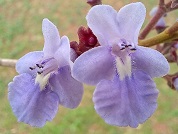Floral biology, reproductive system and floral visitors of Vitex cymosa (Lamiaceae)
DOI:
https://doi.org/10.14522/darwiniana.2023.111.1096Keywords:
Floral and post-floral nectary, floral attractants, floral micromorphology, floral trichomes, floral visitors, flowering phenology, nectarostomes, reproductive systemAbstract
Vitex cymosa Bert. ex Spreng. (Lamiaceae) is a native species of tropical and subtropical Central and South America. Its medicinal, antioxidant, antifungal and antibacterial properties are noteworthy and widely studied. This study aims to contribute towards the knowledge of the reproductive biology of V. cymosa, through: the determination of the reproductive system; the description of reproductive morphological attributes (flower, fruit, pollen and nectary), attractants and floral phases, as well as the record and function of floral visitors. Vitex cymosa presents melitophilic floral traits: diurnal anthesis, bluish coloration, bilabiate structural type, presence of visual guides in the corolla indicating the location of the reward (nectar), and a soft, sweet and pleasant aroma to humans. The pollen has pollenkit and is deposited nototribically on the pollinators. The nectary is of gynoecial origin, the nectar is released through nectarostomes located on the apex of the ovary, remaining available even after corolla abscition, as a post-floral nectary; such zone is distinguished by a purple coloration, different from that of the rest of this organ, which grows basipetally as the fruit develops. The reproductive system of V. cymosa is mixed, resulting in more than 75% of fructification, through both allogamy mediated by pollinators and spontaneous self-pollination, presenting a slight hercogamy that would contribute to cross-pollination. Eleven species of floral visitors were recorded, all belonging to the Class Insecta. Among these floral visitors, Apis mellifera was the most frequent species, and along with other species of native bees (of the genera Bombus, Centris, Plebeia, Tetragonisca, Trigona), wasps and butterflies, they would be pollinators when they visit legitimately (in the case of the hymenopterans, as some of them thieve pollen). Despite this visitor assembly, the most important pollinators are the bees, which coincides with the melitophilic characteristics of the flowers. The nectar exposed in flowers where the corolla has already fallen, more accessible to some bees and to the wasps, would contribute to greater attraction to pollinators, as well as predatory insects of herbivores of the developing fruits.

Downloads
Published
How to Cite
Issue
Section
License

Starting on 2012, Darwiniana Nueva Serie uses Licencia Creative Commons Atribución-NoComercial 2.5 Argentina .





